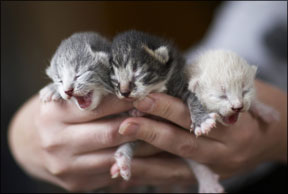Dear Elizabeth, I have always wanted to raise a litter of kittens, and now that my human children are grown, I feel the timing is right for me to pursue my dream. Rather than purposely breeding cats, I was thinking of fostering orphaned kittens for a local shelter. Can you tell me what is involved in raising orphaned kittens? I can think of no better way to add excitement and joy to an empty nest than by raising a litter of orphaned kittens. By fostering kittens for a shelter, you will ease the burden on shelter workers since caring for orphans can be time-consuming. You will also provide an environment free from many of the contagious diseases that are so problematic, and often fatal, to vulnerable youngsters in shelters. Raising orphans is labor intensive, but as you see your tiny, helpless balls of fluff transformed into playful, inquisitive youngsters, Im sure youll consider your time well-spent. Bev Caldwel 288 The kittens will need a nest box, proper nutrition and lots of loving care. The nest box should be a box with sides high enough to prevent the kittens from crawling out and becoming chilled. Newborns must be kept warm during their first two weeks of life when they cant maintain their own body temperatures, and warmth during this time is as critical to their well-being as food. Cardboard boxes work well as inexpensive nest boxes and can be easily replaced if soiled. Cover the bottom of the box with towels which you can replace several times per day – its extremely important to keep the nest box clean, warm and dry. A heating pad – on the lowest setting – should be placed underneath one half of the box so that the kittens can move to the opposite side of the box if they get too warm. Never place the heating pad in the box or burns may result. The entire litter should be kept together so they can huddle together for warmth and develop proper social skills. Buy special kitten formula and pet nursing bottles from your veterinarian or pet store – feeding cows milk is a sure-fire way to cause diarrhea in fragile newborns. Use fine-tipped scissors or a hot needle to make a hole in the nipple just big enough that formula will drip out when the bottle is held upside down and gently squeezed. Too large of a hole will cause the formula to flow too fast and the kittens may choke, too small of a hole will cause the nipple to collapse as the kittens nurse, resulting in frustrated, hungry kittens. Warm the bottle in a cup of hot water rather than in the microwave, which can heat unevenly with scalding hot areas in some portions of the bottle. Time to Feed. Rest the kitten on its stomach and insert the nipple into the kittens mouth. Tip the bottle up so the kittens head and neck are elevated and slightly extended. Be sure the neck of the bottle stays full of milk so air isnt ingested. (If milk comes out the kittens nose, the hole in the nipple is probably too large.) Most kittens will stop nursing when theyre full but, in general, kittens should receive two tablespoons of formula for every four ounces of body weight daily. Very young kittens should be fed every two to four hours throughout the day and night. Some foster parents successfully feed every two hours during the day and every four to eight hours at night, a schedule which allows for a bit of sleep for you! If theyre not gaining well, increase the frequency of feedings and consult your veterinarian. As the kittens grow, they will begin to tell you when theyre hungry and the interval between feedings can be increased. Kittens need assistance in moving their bowels and emptying their bladders in the first few weeks. After each feeding, massage the genital area with a warm, moist washcloth which will simulate licking by their mom. When the kittens are three to four weeks old, canned kitten food can be mixed with formula and slowly introduced. Before you know it, the kittens will be eating on their own, and those sleepless nights will be a distant memory. Have fun and thank you for considering this life-saving and worthwhile mission! Love, Elizabeth 



